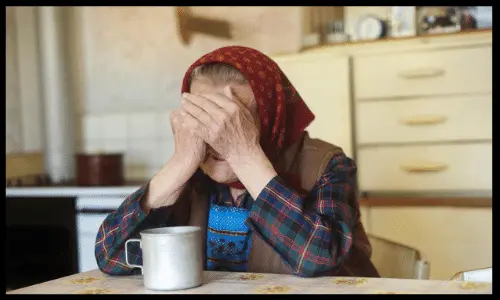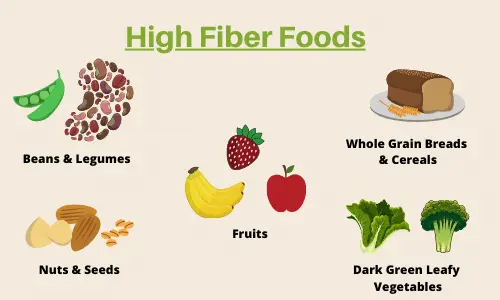Treating Constipation In the Elderly
“Treating Constipation in the Elderly” was written by Kristen LaStofka, dietetic intern at Oregon Health Sciences University (OHSU). Reviewed/edited by Katie Dodd, MS, RDN, CSG, LD, FAND.
Constipation is a common problem in the elderly. Good nutrition is important for older adults and quality of life. Unfortunately, chronic constipation can cause older adult to feel unwell.
As such, they may not want to eat or exercise and may alter their mood, decreasing their quality of life. It is important to be aware of constipation in the elderly and discuss with a geriatric dietitian or other healthcare provider.
What is Constipation
Constipation impacts regular bowel movements. It can include:
- Difficulty having a bowel movement
- Less frequent bowel movements
- Or a combination of both
Constipation affects people of every age. However, it is more common in the elderly population. Females experience severe constipation more frequently than men. (1)
Approximately 30-40% of those over age 60 experience chronic constipation (2).
Signs and Symptoms
Common signs and symptoms of constipation include (2):
- hard stools
- straining
- sensation of blockage
- sensation of incomplete passing of stool
- fewer than 3 bowel movements per week
- the need to manually help stool to come out
Constipation is diagnosed if you experience 2 or more of these symptoms at least 25% of the time.
In addition, seniors may also experience bloating, fullness or abdominal discomfort. Untreated constipation increases the risk of impaction (stool getting stuck) and may result in hospitalization. (3)
Constipation Causes
Constipation can be caused by many different reasons and situations. Sometimes people just experience constipation without a specific underlying cause.
 Potential causes of constipation include (2, 3):
Potential causes of constipation include (2, 3):
- Inadequate fluid intake or dehydration
- Inadequate fiber intake
- Medication side effects
- Electrolyte imbalances
- Structural issues with colon
- Neurological disorders, such as Parkinson’s disease, MS, etc.
- Metabolic issues, such as diabetes, hypothyroidism, hypercalcemia, etc.
Hormonal changes in younger women can also contribute to constipation.
Constipation and Medications
It is important to keep track of medications that are being taken (including supplements!). Certain medications can cause or worsen constipation in older adults.
Medications that can contribute to constipation include (2):
- Muscle relaxants, anti-nausea medications
- Nonsteroidal Anti-Inflammatory Agents
- Antidepressants and Antipsychotics
- Opiates painkillers, such as oxycodone, morphine and codeine
- Anti-hypertensive medications, such as calcium channel blockers
- Diuretics
- Some forms of supplements, such as iron or calcium
Work with your healthcare team to find out if any medications or supplements could be contributing to your constipation. Never stop taking any medication without consulting your doctor. Everyone experiences different side effects from medications.
Treating and Preventing Constipation
In treating and preventing constipation, the first line of defense focuses on lifestyle changes! Specifically, this includes changes to diet, fluid intake, and exercise.
Diet and Constipation
In terms of diet, the recommendation is to gradually increase fiber intake as tolerated. Fiber is a key nutrient that helps keeps your bowels healthy!
 Fiber can be found in a variety of foods, such as (4):
Fiber can be found in a variety of foods, such as (4):
- whole grain breads and cereals
- vegetables
- fruits
- legumes
- beans
- nuts
- seeds
Prunes are commonly recommended as they contain fiber as well as sorbitol, which is a type of indigestible sugar that pulls water into the bowel to help things flow through easier. (4)
There also are some foods that could be considered “problem foods” worsening constipation. Those may include: Alcohol, processed grains, dairy products, fried foods, and red meat.
If these foods are contributing to constipation, start avoiding or reducing your intake of the ones listed above. Every person is individual so experiment with an eating pattern that best works for you. Focus on adding in more fiber first.
Fluid and Constipation
 Drinking enough fluids is key in preventing constipation as it softens the stool making it easier to pass.
Drinking enough fluids is key in preventing constipation as it softens the stool making it easier to pass.
Try to consume at least six 8-ounce glasses of water each day. If plain water is not always appealing, adding a flavor enhancer or infusing water with fruit is an option.
Learn more in our article on Dehydration in Elderly.
Don’t forget all the other ways fluids can get into your body! Soups, broths, and foods with higher water content, such as cucumbers, apples, bell pepper and watermelon, can also increase fluid intake. Prune juice has also been shown to be effective in treating constipation. (4)
Tips for Hydration:
- Drink water before, during, and after meals
- Have set times to drink water each day
- Carry a water bottle or have a water glass nearby during the day
- Eat foods with higher water content (i.e. soups, fruit, vegetables)
- Limit sugary drinks and caffeine
- Add flavor enhancers or infuse water with fruits.
Exercise and Constipation
 Physical activity has been shown to help keep the bowels moving regularly and aid in preventing constipation.
Physical activity has been shown to help keep the bowels moving regularly and aid in preventing constipation.
The Physical Activity Guidelines for Americans recommends older adults should do multicomponent physical activity that incorporates balance training, aerobic and muscle strengthening exercises. (5)
Physical activity, in combination with adequate fiber and fluid, is an excellent way to prevent and treat constipation in the elderly.
Treating Constipation with the Help of Medications
Some people may need further drug therapy if lifestyle changes are not resolving the issue.
There are many common over the counter medications that can be purchased. Some are safer and more effective than others for constipation. Always talk to your healthcare team before starting medications for constipation.
 Recommendations will be individualized based on your individual situation.
Recommendations will be individualized based on your individual situation.
Taking medications without first consulting your doctor can increase risk of harm.
Especially if there is an underlying health issue going on.
There are various categories of laxatives including: osmotic, stimulant, bulking and stool softeners.
Osmotic Agents
Osmotic agents are considered the most safe and effective treatment that function by pulling water into the bowel and retaining water in the colon, which leads to contents flowing through easier. (2,3)
Some of the common osmotic laxatives include polyethylene glycol (Miralax), magenesium citrate based products, phosphate based products, such as Fleets products, and non-absorbable carbohydrates, such as sorbitol.
Stimulant Laxatives
Stimulant laxatives trigger contractions in the intestines to help push the stool through the digestive tract. Common stimulant laxatives include Senna and Bisacodyl (Dulcolax).
Stimulant laxatives can cause excessive cramping and should be used sparsely, only after trying fiber and osmotic laxatives. (6)
Bulking Agents (Fiber Supplement)
Bulk forming laxatives are also known as fiber supplements absorb water into the intestines, creating a more bulky, liquidous stool that is easier to pass. Some common fiber supplements include Psyllium (Metamucil) and methylcellulose (Citrucel).
Since these laxatives are fiber based it is critical to increase fluid intake to ensure an obstruction does not develop. (3)
Stool Softener
Stool softeners allow water and fats to enter the stool, making it softer and easier to pass through. A common stool softener is docusate sodium (Colace). Stool softeners should not be taken for more than a week and relief should be seen within a couple days. (7)
Most laxatives should not be taken for extended periods of time, talk with the doctor before starting laxatives. If the problem persists, talk with your doctor about alternative treatments.
Conclusion
Now that we know what constipation is, potential causes, signs and symptoms and lines of treatment, it’s time to apply them! Don’t forget to check with your healthcare team too!
Get active, drink water and incorporate those high fiber foods into your diet. Awareness is the first step, now it’s time to take action and move towards a happier, healthier life!
Be sure to rule out any other potential underlying issues with a doctor.

References
- Vazquez Roque M, Bouras EP. Epidemiology and management of chronic constipation in elderly patients. Clin Interv Aging. 2015;10:919-930. Published 2015 Jun 2. doi:10.2147/CIA.S54304
- Jani B, Marsicano E. Constipation: Evaluation and Management. Mo Med. 2018;115(3):236-240.
- Emmanuel A, Mattace-Raso F, Neri MC, Petersen KU, Rey E, Rogers J. Constipation in older people: A consensus statement. Int J Clin Pract. 2017;71(1):10.1111/ijcp.12920. doi:10.1111/ijcp.12920
- Gallegos-Orozco JF, Foxx-Orenstein AE, Sterler SM, Stoa JM. Chronic constipation in the elderly. Am J Gastroenterol. 2012;107(1):18-26. doi:10.1038/ajg.2011.349
- Piercy KL, Troiano RP, Ballard RM, et al. The Physical Activity Guidelines for Americans. JAMA. 2018;320(19):2020-2028. doi:10.1001/jama.2018.14854
- Mounsey A, Raleigh M, Wilson A. Management of Constipation in Older Adults. Am Fam Physician. 2015;92(6):500-504
- Treatments for Constipation: A Review of Systematic Reviews. Ottawa (ON): Canadian Agency for Drugs and Technologies in Health; November 17, 2014.

I appreciate your web site! This article mentions Bisacodyl then has Bulcolax in ( ). I think this should be Dulcolax?
Good catch! You are right. That B should be a D. I’ll go fix in now. Thank you!
Do you have any experience using high fibre juice (resistant maltodexrin) in elderly population to prevent constipation?
I do not have any experience with this product. But thanks for sharing, this sounds like something I need to do some research on!